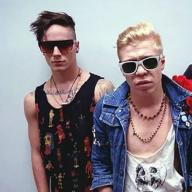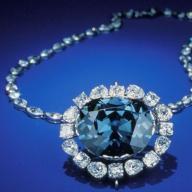The word "melange" means "mixture" in French. The term applies to both knitting yarn and textiles. Linen or melange knitwear is a material in the production of which threads with different textures, thicknesses and colors are used as raw materials. As a result, a fabric with an unusual texture or combination of colors is formed. The secret of making melange has been known for hundreds of years; nowadays this material is becoming increasingly popular.
What is melange
Melange is practical and at the same time looks very impressive. The original color is formed by combining multi-colored fibers during manufacturing or as a result of stepwise contrasting or smooth coloring of the finished material.
Melange textiles can be:
- “Grainy” in appearance, when up close the fabric looks colorful, but from a distance it looks monochromatic.
- Painted in fragments of various configurations and sizes, where the shades smoothly transition into one another. Knitted fabrics and hand-knitted items are most often produced in this way.

What is melange? The first such materials were woven from untreated cotton fibers, which had various shades and were called “motley” or gray fiber. These were inexpensive and very durable materials. Over time, the fabric became more and more popular; twisted cotton fibers, carefully cleaned, mercerized and finished, began to be used for its production. Cotton variegated fabrics are still produced today.
When producing melange, each manufacturer uses its own technologies and methods of blending and color combinations. The pattern is formed by using two contrasting shades or as a result of mixing several colors, which results in very unusual and effective colors.

The following raw materials are used to make melange:
- cotton yarn;
- cotton fibers dyed in various shades;
- natural wool (undyed and dyed);
- nylon, nitron, lavsan and other synthetic fibers.
Melange fabrics can look different depending on the angle of incidence of light and distance; a similar effect is not possible with conventional dyeing of the material.
Advantages of melange:
- many color options;
- Thanks to the combination of fibers of different colors and compositions, the material can have excellent characteristics and performance properties.
Melange has only one drawback - depending on the fibers it contains, the fabric may require special care.

Varieties and properties
There are many varieties of melange fabric. The most popular are:
- melange cloth- used for sewing casual suits, warm woolen material;
- drape melange- used for the manufacture of demi-season, winter and warm clothes, can be with pile or smooth, two-color and multi-color;
- carpetcat- with a melange pattern, the surface has a characteristic scar due to the diagonal weave of the threads;
- Cheviot- consists of wool, in some cases mixed with cotton fibers, used for sewing uniforms, skirts, suits, trousers;
- tights- fabric for making sportswear and trousers.

Synthetic threads in the production of melange cause unusual color effects and interesting relief of the fabric. The performance characteristics of the material are improved: elasticity, wrinkle resistance, strength, no shrinkage after washing.
Where is it used?
Melange is actively used for sewing dresses, suits, items outerwear. Melange is used to make furniture upholstery and various accessories. Caring for products is not always difficult; the features depend on the composition of the fabric.
Advice! Melange is perfect for creating casual or street style, because it looks very impressive.

Care
Proper care of mélange products will ensure their excellent appearance and long-term operation:
- It is recommended to wash any type of melange in warm water.
- Bleach should not be used when washing.
- Melange made from a mixture of synthetic and natural fibers tolerates washing in automatic washing machines.
- For fabrics made from woolen threads, it is recommended to use neutral detergents.
- must be done in the “Delicate wash” or “Wool” mode.
- Melange products must be dried in the shade.
- It is recommended to iron from the wrong side, and the temperature should be selected in accordance with the composition of the fabric, focusing on the most fusible fibers.
126 0
fabric made from single-strand or twisted melange yarn. It differs from variegated and dyed fabrics in its unique color effect: white sparkles on a dark background, gray colors different lightness, various shades of green, beige and other colors. The most famous are M.T. (cotton and wool) - tights, carpet, diagonal, cloth. For woolen M.T., the word “melange” is added to the usual name: cloth-melange, drape-melange, etc.
Meanings in other dictionaries
Melange fabric
fabric made from single-strand or twisted melange yarn (See Melange yarn). It differs from multi-colored or dyed fabrics in its unique color effect. When finishing cotton fabrics, they are not subjected to bleaching, because it destroys the color of the fiber; The finishing process comes down mainly to mechanical processing (cutting, napping, etc.) and finishing (See Finishing...
Melange Fabric
MELANGE FABRIC - produced from single-strand or twisted melange yarn, obtained from a mixture of fibers dyed in different colors. Cotton melange fabrics are common: leotard, cheviot, suit leotard, carpet coat, cloth. Woolen melange fabrics are called cloth melange, drape melange, etc...
Melange Fabric
is produced from single-strand or twisted melange yarn obtained from a mixture of fibers dyed in different colors. Cotton melange fabrics are common: leotard, cheviot, suit leotard, carpet coat, cloth. Woolen melange fabrics are called cloth melange, drape melange, etc...
Melange yarn
yarn made from a mixture of fibers dyed in different colors. The fibers are mixed in storage sheds and on the feed grids of opening-scattering machines, and the semi-finished products are mixed in one or more shops of the spinning mill; canvases - on the grid of scutching machines, strips - on carding tape-joining or draw machines, tape - on roving and spinning machines. The fiber is usually dyed before spinning...
The term "melange" is borrowed from French, and is translated as “mixture”. Both knitwear and melange fabric are materials in the manufacture of which yarn of different colors, thicknesses and textures is used. The result is a canvas with multivariate combinations of tones and/or original surface texture, and its general form depends on the combination of paints and the thickness of the fibers of the raw materials. Such materials were manufactured centuries ago, and nowadays their popularity is only increasing.
What is melange?
The definition of melange falls very broad group materials that are woven or knitted from dissimilar threads. Classic melange fabric includes both ancient rugged canvas and elegant materials such as bouclé, cheviot, etc., and practical needlewomen create hand-knitted melange knitwear by combining leftovers different types yarn. As a rule, melange is a textile whose structure consists of multi-colored dots, their size depends on the thickness of the original fibers. As a rule, two types of threads are used, which can either be contrasting or complement each other in tone, but many materials, especially knitwear, allow a greater number of shades.
When creating a canvas on loom usually use single-strand warp and weft different shades, which allows you to get a canvas with “sparkles” (with contrasting colors) or a gradient shade between the original colors. Hand-woven and machine-made knitwear is made from pre-twisted threads, which allows you to achieve the most unexpected colorful effects.
With all the diversity of its characteristics, melange fabric has common properties, namely:
- strength;
- beautiful and original appearance;
- practicality.
Traditional melange is a fabric made from one type of fiber (wool, cotton, flax), but in recent decades synthetics have been almost constantly added to these materials. When purchasing, the composition of the fabric must be carefully monitored, since it does not always correspond to the stated name. For example, the widespread and inexpensive Angora melange not only does not include Angora fluff, but is not even melange in the exact sense of the word.
High-quality, durable and beautiful melange fabric can only be obtained from good-quality raw materials, which are used as strong, well-twisted threads of different shades. They are pre-dyed, but sometimes the colors of the threads are natural (for example, unbleached cotton or wool in various natural shades). The finished canvas can be subjected to finishing ( cotton fabrics) or napping (wool, synthetics), but never dyed. 
Industrial melange knitwear is made from single-strand yarn with step-dyeing or twisted dissimilar threads. The same yarn is used for hand knitting, in most cases, the craftswoman selects the original threads for twisting herself. It must be remembered that independently selecting base threads can be a very difficult task; the main attention should be paid not only to harmonious combinations of colors, but also to their stability during washing. But choosing a model made of melange material does not present any difficulties - the simpler it is, the more impressive the play of colors will look.
How to wash products?
The rules for caring for melange fabric are determined by what fibers are included in its composition. In any case, use is not recommended hot water, detergents with bleach or tinting effect, dry in the sun. For mixed melange, washing and ironing modes are determined by the most delicate fiber included in its composition (for example, mohair or lycra). Items made of melange with added wool or fluff should be protected from moths.
Melange fabric fabric made from single-strand or twisted melange yarn (See Melange yarn). It differs from multi-colored or dyed fabrics in its unique color effect. When finishing cotton fabrics, they are not subjected to bleaching, because it destroys the color of the fiber; the finishing process comes down mainly to mechanical processing (cutting, napping, etc.) and finishing (See Finishing) of fabrics. The finishing of woolen fabrics does not differ from the usual finishing of fabrics. The most common cotton fabrics are: leotard, cheviot, suit leotard, diagonal, carpet coat, cloth. For woolen textiles, the word “melange” is added to the usual name, for example, cloth-melange, drape-melange, etc.
Great Soviet Encyclopedia. - M.: Soviet Encyclopedia. 1969-1978 .
See what “Melange fabric” is in other dictionaries:
It is produced from single-strand or twisted melange yarn obtained from a mixture of fibers dyed in different colors. Cotton melange fabrics are common: leotard, cheviot, suit leotard, carpet coat, cloth. Woolen melange fabrics... ... Big Encyclopedic Dictionary
It is produced from single-strand or twisted melange yarn obtained from a mixture of fibers dyed in different colors. Cotton melange fabrics are common: leotard, cheviot, suit leotard, carpet coat, cloth. Woolen melange fabrics... ... encyclopedic Dictionary
Melange fabric- fabric made from single-strand or twisted melange yarn. It differs from multi-colored and dyed fabrics in its unique color effect: white sparkles on a dark background, gray colors of varying lightness, various shades of green, beige and... ... Encyclopedia of fashion and clothing
Melange fabric- Melange fabric: fabric produced from yarn made from fibers dyed in various colors... Source: COTTON AND MIXED HOUSEHOLD FABRICS. GENERAL TECHNICAL CONDITIONS. GOST 29298 2005 (introduced by the Order of Rostekhregulirovaniya dated... ... Official terminology
Another name for this concept is “Melange”; see also other meanings... Wikipedia
A product formed during the weaving process (See Weaving) by interweaving mutually perpendicular longitudinal (warp) and transverse (weft) threads. In some cases, additional thread systems are used... ... Great Soviet Encyclopedia
This term has other meanings, see Tweed. Sample of tweed fabric Tweed (eng. tweed) woolen fabric, elastic, medium ... Wikipedia
This is a special yarn for hand and machine knitting, which consists of a mixture of fibers of the same or different types of different colors. Mixed into one thread, they give the effect of a smooth and soft transition from one shade to another.
What kind of yarn is there?
It may consist of one thread, two or several. This usually happens if there are various additives: shiny or synthetic threads. Previously, many needlewomen made such yarn on their own, connecting threads different colors. Today you can buy it in any store. However, not all women can confidently answer the question: “Melange - what is it?”
Differences in composition
Melange threads vary in their composition. They are:
- cotton;
- woolen;
- mohair;
- acrylic.
Cotton is hygienic, washable, absorbs moisture well and allows air to pass through. Finished products made from such yarn are very comfortable and pleasant to wear.

Mohair melange yarn very warm and durable, airy and soft. Its disadvantages include rolling and prickliness.
Wool yarn can retain heat well and is hygroscopic. Great for knitting textured and smooth patterns.
Acrylic can be described as a durable, thermoplastic, light-resistant material. This yarn dyes well, making the threads bright and shiny. Acrylic yarn can be used for hand or machine knitting.
How is this yarn made?
For its production, a ready-made thread is used, which is dyed at regular intervals. If you knit small items with such threads, the pattern turns out large. Today such yarn is produced according to modern technologies, so it is very practical and high quality.
Quite often the concept of “melange” is not quite correctly interpreted: that it is a connection that cannot be compared with a purely mechanical interweaving of multi-colored threads. If you wind two or three multi-colored threads into one ball and knit the product, it will not be melange, but simply variegated.
How to make the right choice

So, you are ready to buy melange. You already understand what it is, now we’ll learn how to do it right choice quality product. Pay attention to the elasticity of the thread, its strength, twist, and uniformity of coloring. If the thread is too twisted, it will not be suitable for knitting. It is designed for crocheting. Also ready product may turn out to be skewed, and no amount of ironing will save it.
The elasticity of the thread is checked quite simply: pull it, if it springs, then you have a quality product in your hands. It is very important that the melange thread does not have thickenings. Read the label carefully. It must indicate the percentage of different fibers, the length and weight of the thread, recommendations for choosing knitting needles and knitting density. These recommendations should not be ignored; they are given by experienced specialists from manufacturers based on numerous tests. Melange knitting is a fun and interesting activity.
What can you knit from melange
As a rule, this yarn consists of natural fibers (although you can also find completely synthetic yarn), so you can make any thing from it: sweaters, jackets, skirts, scarves, hats, mittens. Don’t throw away the rest of the yarn, knit squares from them, and when you have collected enough, assemble “Melange” with knitting needles - these are always very impressive and stylish things.
A color scheme

Typically, melange yarn has one color, but different shades. But there are samples of different colors. In this case, you should select them so that they are harmoniously combined with each other. It is advisable to adhere to simple rules for combining colors. Compositions such as:
- purple and lilac (close colors);
- yellow and orange (two bright tones);
- pink and yellow (two faded shades).
Remember that it always looks great with any tone White color. Scarlet looks interesting with blue, black, yellow, and brown with green.
Advantages and disadvantages of melange
All the pros and cons of yarn stem from its composition. If the thread consists of fibers of the same type, this usually leads to negative consequences. For example, pure wool yarn may fall off, cotton may stretch, synthetics will not allow the skin to “breathe”. Study the composition carefully!
The obvious advantages of this yarn include its spectacular appearance and the optimal thread thickness for hand knitting. Thanks to the variegated colors, the yarn successfully hides knitting imperfections and does not require the use of complex patterns.
In our article we talked about melange yarn. high-tech fiber that can be used for hand and machine knitting. This yarn is very popular among amateurs and professionals. Things made from it are warm, beautiful, light. It is valuable that beginners can successfully use it, because it reliably hides all errors in the work.




